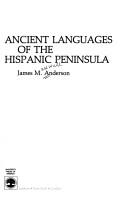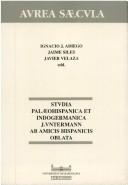| Listing 1 - 10 of 12 | << page >> |
Sort by
|

ISBN: 0819167312 Year: 1988 Publisher: Lanham New York London University Press of America
Abstract | Keywords | Export | Availability | Bookmark
 Loading...
Loading...Choose an application
- Reference Manager
- EndNote
- RefWorks (Direct export to RefWorks)
Book
ISBN: 840004584X 9788400045845 Year: 1980 Volume: 66 Publisher: Valencia : Diputacion provincial de Valencia,
Abstract | Keywords | Export | Availability | Bookmark
 Loading...
Loading...Choose an application
- Reference Manager
- EndNote
- RefWorks (Direct export to RefWorks)

ISBN: 8447504182 Year: 1993 Publisher: Barcelona Universitat de Barcelona
Abstract | Keywords | Export | Availability | Bookmark
 Loading...
Loading...Choose an application
- Reference Manager
- EndNote
- RefWorks (Direct export to RefWorks)
Iberian language --- Inscriptions, Iberian --- Portugal --- Spain --- Antiquities.
Book
ISBN: 9780984538362 0984538364 9780984538331 098453833X Year: 2015 Publisher: Washington (D.C.) : Institute for the study of man,
Abstract | Keywords | Export | Availability | Bookmark
 Loading...
Loading...Choose an application
- Reference Manager
- EndNote
- RefWorks (Direct export to RefWorks)
Inscriptions, Iberian. --- Celtic languages, Continental. --- Celtic languages, Continental. --- Inscriptions, Iberian. --- Language and languages. --- Spain --- Spain. --- Languages.
Book
ISBN: 9788470093579 8470093576 Year: 1992 Publisher: Santo Domingo de Silos: Abadía de Silos,
Abstract | Keywords | Export | Availability | Bookmark
 Loading...
Loading...Choose an application
- Reference Manager
- EndNote
- RefWorks (Direct export to RefWorks)
Coins, Roman --- Coins, Ancient --- Inscriptions, Latin --- Inscriptions, Iberian
Book
ISBN: 840005184X 9788400051846 Year: 1982 Volume: 76 Publisher: Valencia : Diputacion provincial de Valencia,
Abstract | Keywords | Export | Availability | Bookmark
 Loading...
Loading...Choose an application
- Reference Manager
- EndNote
- RefWorks (Direct export to RefWorks)
Inscriptions, Iberian --- Iberian language --- Leadwork --- Etymology --- Mogente (Spain) --- Antiquities --- Iberians --- Etymology. --- Spain --- Antiquities. --- Inscriptions, Iberian - Spain - Mogente --- Iberian language - Etymology --- Leadwork - Spain - Mogente --- Mogente (Spain) - Antiquities
Book
ISBN: 8450515483 Year: 1985 Publisher: Valencia : Diputacion provincial de Valencia,
Abstract | Keywords | Export | Availability | Bookmark
 Loading...
Loading...Choose an application
- Reference Manager
- EndNote
- RefWorks (Direct export to RefWorks)
Inscriptions, Iberian --- Catalogs. --- Catalogs --- Iberien (l.) --- Museo de prehistoria de valencia (espagne) --- Textes
Book
ISBN: 8460006743 Year: 1976 Volume: 95 Publisher: [Salamanca] : Universidad de Salamanca,
Abstract | Keywords | Export | Availability | Bookmark
 Loading...
Loading...Choose an application
- Reference Manager
- EndNote
- RefWorks (Direct export to RefWorks)
Inscriptions, Iberian --- Inscriptions, Celtiberian --- Inscriptions celtibériennes --- Congresses --- Congresses --- Congrès --- Spain --- Portugal --- Languages --- Congresses. --- Languages --- Congresses.
Multi
ISSN: 04189736 ISBN: 9783110350852 3110350858 Year: 2014 Volume: 20 Publisher: Berlin ; Boston De Gruyter
Abstract | Keywords | Export | Availability | Bookmark
 Loading...
Loading...Choose an application
- Reference Manager
- EndNote
- RefWorks (Direct export to RefWorks)
Inscriptions, Iberian --- Iberian language --- History --- Alt Empordà (Spain) --- Baix Empordà (Spain) --- France, Southern --- Antiquities --- Inscriptions, Iberian - France, Southern --- Inscriptions, Iberian - Spain - Ampurdán (Region) --- Iberian language - France, Southern - History --- Iberian language - Spain - History --- Alt Empordà (Spain) - Antiquities --- Baix Empordà (Spain) - Antiquities --- France, Southern - Antiquities
Book
ISBN: 0198790821 9780198790822 0191833274 0192508172 Year: 2019 Publisher: Oxford Oxford University Press
Abstract | Keywords | Export | Availability | Bookmark
 Loading...
Loading...Choose an application
- Reference Manager
- EndNote
- RefWorks (Direct export to RefWorks)
In addition to Phoenician, Greek, and Latin, at least four writing systems were used between the fifth century BCE and the first century CE to write the indigenous languages of the Iberian peninsula (the so-called Palaeohispanic languages): Tartessian, Iberian, Celtiberian, and Lusitanian. In total over three thousand inscriptions are preserved in what is certainly the largest corpus of epigraphic expression in the western Mediterranean world, with the exception of0the Italian peninsula. 0The aim of this volume is to present the most recent cutting-edge scholarship on these epigraphies and on the languages that they transmit. Utilizing a multidisciplinary approach which draws on the expertise of leading specialists in the field, it brings together a broad range of perspectives on the linguistic, philological, epigraphic, numismatic, historical, and archaeological aspects of the surviving inscriptions, and provides invaluable new insights into the social, economic, and cultural history of Hispania and the ancient western Mediterranean. The study of these languages is essential to our understanding of colonial Phoenician and Greek literacy, which lies at the root of their growth, as well as of the diffusion of Roman literacy, which played an important role in the final expansion of the so called Palaeohispanic languages.
Inscriptions, Ancient --- Inscriptions, Celtiberian. --- Inscriptions, Iberian. --- Inscriptions, Ancient. --- Language and languages. --- To 218 B.C. --- Iberian Peninsula --- Spain --- Portugal --- Europe --- Portugal. --- Spain. --- Languages --- History. --- History
| Listing 1 - 10 of 12 | << page >> |
Sort by
|

 Search
Search Feedback
Feedback About UniCat
About UniCat  Help
Help News
News